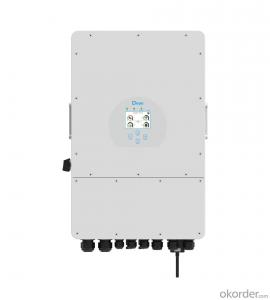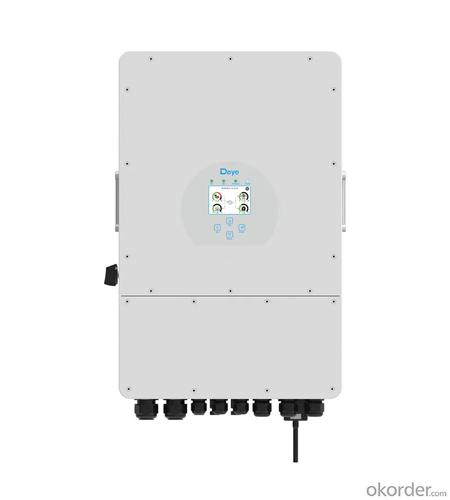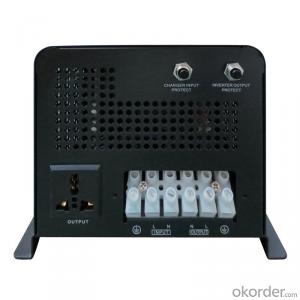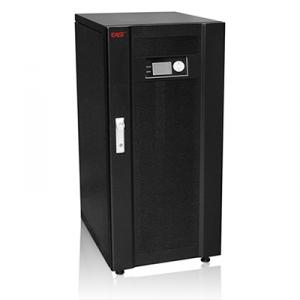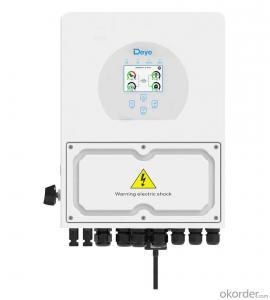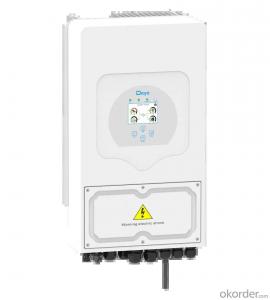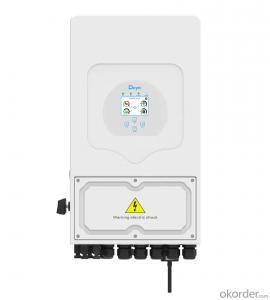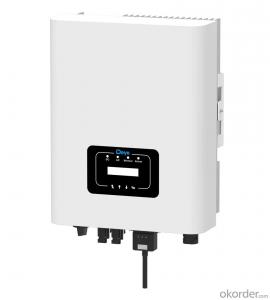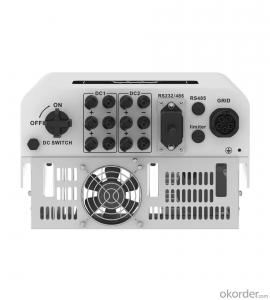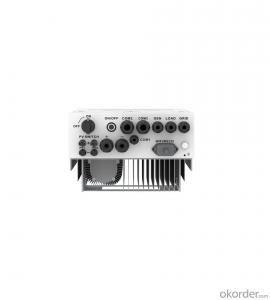Nep Solar Inverter - Sun-5/6/8/10/12k-SG04LP3 Hybrid Inverter Low Voltage Battery Higher Yields
- Loading Port:
- Ningbo
- Payment Terms:
- TT OR LC
- Min Order Qty:
- 100 pc
- Supply Capability:
- 5000 pc/month
OKorder Service Pledge
OKorder Financial Service
You Might Also Like
Specification
Higher yields / Safe & Reliable / Smart / User-friendly
SUN 5/6/8/10/12K-SG is brand new three phase hybrid inverter with low battery voltage 48V, ensuring system safe and reliable. With compact design and high-power density, this series supports 1.3 DC/AC ratio, saving device investment. It supports three phase unbalanced output, extending the application scenarios. Equipped with CAN port (x2) BMS and parallel, x1 RS485 port for BMS, x1 RS232 port for remotely control, x1 DRM port, which makes the system smart and flexible.
100% unbalanced output, each phase; Max. output up to 50% rated power
DC couple and AC couple to retrofifit existing solar system
Max. 16pcs parallel for on-grid and offff-grid operation; Support multiple batteries parallel
Max. charging/discharging current of 240A
48V low voltage battery, transformer isolation design
6 time periods for battery charging/discharging
Support storing energy from diesel generator
| Technical Data | |||||||
| Model | SUN-5K -SG04LP3-EU | SUN-6K -SG04LP3-EU | SUN-8K -SG04LP3-EU | SUN-10K -SG04LP3-EU | SUN-12K -SG04LP3-EU | ||
| Battery Input Data | |||||||
| Battery Type | Lead-acid or Li-lon | ||||||
| Battery Voltage Range (V) | 40~60 | ||||||
| Max. Charging Current (A) | 120 | 150 | 190 | 210 | 240 | ||
| Max. Discharging Current (A) | 120 | 150 | 190 | 210 | 240 | ||
| External Temperature Sensor | Yes | ||||||
| Charging Curve | 3 Stages / Equalization | ||||||
| Charging Strategy for Li-Ion Battery | Self-adaption to BMS | ||||||
| PV String Input Data | |||||||
| Max. DC Input Power (W) | 6500 | 7800 | 10400 | 13000 | 15600 | ||
| Rated PV Input Voltage (V) | 550 (160~800) | ||||||
| Start-up Voltage (V) | 160 | ||||||
| MPPT Voltage Range (V) | 200-650 | ||||||
| Full Load DC Voltage Range (V) | 350-650 | ||||||
| PV Input Current (A) | 13+13 | 26+13 | |||||
| Max. PV ISC (A) | 17+17 | 34+17 | |||||
| Number of MPPT / Strings per MPPT | 2/1+1 | 2/2+1 | |||||
| AC Output Data | |||||||
| Rated AC Output and UPS Power (W) | 5000 | 6000 | 8000 | 10000 | 12000 | ||
| Max. AC Output Power (W) | 5500 | 6600 | 8800 | 11000 | 13200 | ||
| AC Output Rated Current (A) | 7.6 | 9.1 | 12.1 | 15.2 | 18.2 | ||
| Max. AC Current (A) | 11.4 | 13.6 | 18.2 | 22.7 | 27.3 | ||
| Max. Continuous AC Passthrough (A) | 45 | ||||||
| Peak Power (off grid) | 2 time of rated power, 10 S | ||||||
| Power Factor | 0.8 leading to 0.8 lagging | ||||||
| Output Frequency and Voltage | 50/60Hz; 3L/N/PE 220/380, 230/400Vac | ||||||
| Grid Type | Three Phase | ||||||
| DC injection current (mA) | THD<3% (Linear load<1.5%)< td=""> | ||||||
| Efficiency | |||||||
| Max. Efficiency | 97.60% | ||||||
| Euro Efficiency | 97.00% | ||||||
| MPPT Efficiency | 99.90% | ||||||
| Integrated | PV Input Lightning Protection, Anti-islanding Protection, PV String Input Reverse Polarity Protection, Insulation Resistor Detection, Residual Current Monitoring Unit, Output Over Current Protection, Output Shorted Protection, Surge protection | ||||||
| Output Over Voltage Protection | DC Type II/AC Type III | ||||||
| Certifications and Standards | |||||||
| Grid Regulation | CEI 0-21, VDE-AR-N 4105, NRS 097, IEC 62116, IEC 61727, G99, G98, VDE 0126-1-1, RD 1699, C10-11 | ||||||
| Safety EMC / Standard | IEC/EN 61000-6-1/2/3/4, IEC/EN 62109-1, IEC/EN 62109-2 | ||||||
| General Data | |||||||
| Operating Temperature Range (℃) | -45~60℃, >45℃ derating | ||||||
| Cooling | Smrat cooling | ||||||
| Noise (dB) | <45 dB | ||||||
| Communication with BMS | RS485; CAN | ||||||
| Weight (kg) | 33.6 | ||||||
| Size (mm) | 422W x 699.3H x279D IP65 | ||||||
| Protection Degree | IP65 | ||||||
| Installation Style | Wall-mounted | ||||||
| Warranty | 5 years | ||||||
- Q: How does a solar inverter affect the overall aesthetics of a solar installation?
- A solar inverter does not have a significant impact on the overall aesthetics of a solar installation. Inverters are typically mounted in discreet locations, such as on the side of a building or inside a garage, where they are not visible from the street or prominent areas. Therefore, the inverter's presence does not greatly affect the visual appeal of the solar system.
- Q: How does a solar inverter convert DC to AC?
- A solar inverter converts direct current (DC) electricity generated by solar panels into alternating current (AC) electricity that can be used to power appliances and feed into the electrical grid. It does this by using a complex electronic circuit that first converts the DC power into high-frequency AC power. This high-frequency AC power is then transformed into the desired voltage and frequency of standard AC power using pulse-width modulation techniques. The converted AC power can then be utilized for various household or commercial electrical needs.
- Q: What is the role of a maximum power point tracker in a solar inverter?
- The role of a maximum power point tracker (MPPT) in a solar inverter is to ensure that the solar panels are operating at their maximum power output. The MPPT continuously monitors the voltage and current of the solar panels and adjusts the operating conditions to find and maintain the maximum power point. This optimization helps to maximize the efficiency and overall energy generation of the solar system.
- Q: Are solar inverters compatible with different solar panel technologies?
- Yes, solar inverters are generally compatible with different solar panel technologies. Inverters are designed to convert the DC electricity produced by solar panels into AC electricity that can be used in homes or fed back into the grid. They are built to work with various types of solar panels, such as monocrystalline, polycrystalline, and thin-film panels. However, it is important to ensure that the inverter selected is appropriate for the specific voltage and power output of the solar panels being used.
- Q: Can a solar inverter be connected to a smart home or monitoring system?
- Yes, a solar inverter can be connected to a smart home or monitoring system. This allows for seamless integration and monitoring of the solar system's performance and energy production. This connection enables homeowners to track their energy usage, receive real-time updates on energy generation, and even remotely control and optimize the solar system's settings.
- Q: How does a solar inverter protect against lightning strikes?
- A solar inverter typically protects against lightning strikes by incorporating surge protection devices and grounding systems. These features help to divert the excess energy caused by a lightning strike away from the sensitive electronic components of the inverter, preventing damage and potential electrical hazards.
- Q: Can a solar inverter be used in areas with high levels of lightning activity?
- Yes, a solar inverter can be used in areas with high levels of lightning activity. However, it is important to ensure that the inverter is designed to withstand lightning strikes and has appropriate surge protection measures in place to prevent damage. Additionally, proper grounding and installation by a qualified professional are crucial to mitigate any potential risks associated with lightning strikes.
- Q: What is the role of a solar inverter in a solar-powered electric vehicle charging station?
- The role of a solar inverter in a solar-powered electric vehicle charging station is to convert the direct current (DC) generated by the solar panels into alternating current (AC) that can be used to charge electric vehicles. The inverter ensures that the electricity produced by the solar panels is compatible with the charging station and the electric vehicles, allowing for efficient and safe charging.
- Q: Can a solar inverter be repaired or serviced?
- Yes, a solar inverter can be repaired or serviced. Inverters are complex electronic devices that can experience faults or malfunctions over time. Depending on the issue, a qualified technician can diagnose and repair the inverter, replacing faulty components if necessary. Regular maintenance and servicing can also help identify potential problems and ensure optimal performance of the solar inverter.
- Q: Can a solar inverter be used with different types of energy management systems?
- Yes, a solar inverter can be used with different types of energy management systems. Solar inverters are designed to convert the DC (direct current) electricity generated by solar panels into AC (alternating current) electricity that can be used to power various electrical devices and appliances. These inverters can be integrated with different energy management systems, such as smart grids or battery storage systems, to optimize energy usage, monitor performance, and enhance overall energy efficiency.
Send your message to us
Nep Solar Inverter - Sun-5/6/8/10/12k-SG04LP3 Hybrid Inverter Low Voltage Battery Higher Yields
- Loading Port:
- Ningbo
- Payment Terms:
- TT OR LC
- Min Order Qty:
- 100 pc
- Supply Capability:
- 5000 pc/month
OKorder Service Pledge
OKorder Financial Service
Similar products
Hot products
Hot Searches
Related keywords
